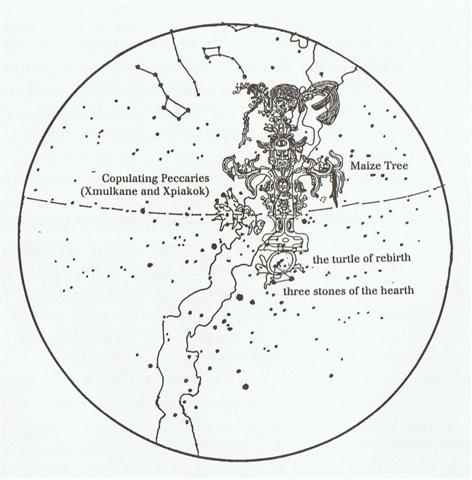7. I do not like coincidences, but it is hard to avoid the conclusion that when the rongorongo texts were created it was a very special time, viz. a time when the distance from the equinox in 'March 21 to the heliacal rising of the 'button' Alzirr was ca 106 (= 471 - 365) right ascension days. That is, it was a time when the equation 471 = 1½ * 314 had a special meaning. Al Bīrūnī who gave us the name Alzirr lived around the year 1000 B.C. (*973, †1048). The precession must have moved Alzirr ahead with ca (1870 - 1000) / 71 = 12 days since his time. The heliacal rising of the 'Button' must have been around day 186 - 12 = 174, or in June 23 - given the Gregorian calendar had been in use at his time. At the time of Al Bīrūnī the heliacal day of ξ Gemini would have been close to the northern midsummer, a reasonable time to imagine a 'rabbit hole' through which the old winter year (alias Castor) could escape. ... nor did Alice think it so very much out of the way to hear the Rabbit say to itself 'Oh dear! Oh dear! I shall be too late!' (when she thought it over afterwards it occurred to her that she ought to have wondered at this, but at the time it all seemed quite natural); but, when the Rabbit actually took a watch out of its waistcoat-pocket, and looked at it, and then hurried on, Alice started to her feet, for it flashed across her mind that she had never before seen a rabbit with either a waistcoat-pocket, or a watch to take out of it, and was just in time to see it pop down a large rabbit-hole under the hedge. In another moment down went Alice after it, never once considering how in the world she was to get out again ... ... Taranga rushed to the door, and the window beside it, and pulled out all the things that Maui had used to stop them up. When she saw that the sun was already in the sky she muttered some angry things and hurried out, holding in front of her a piece of old flax cloak that Maui had used to stop up the door. Away she ran, crying and whimpering in being so badly treated by her children. No sooner was she out of the house than little Maui was on his knees behind the sliding door, which she had closed behind her as she left. He was watching to see which way she went. Not far away he saw her stop and pull up a clump of rushes. There was a hole under it, which she dropped into. She pulled the rushes into place behind her, and was gone. Maui slipped out and ran as fast as he was able to the clump of rushes. He pulled it and it came away, and he felt a wind against his face as he looked through the hole. Looking down, he saw another world, with trees and the ocean, and fires burning, and men and women walking about ... When July 4 became the day of independence, in the year 1776, the 'button' would have risen ca (1870 - 1760) / 71 = ca 1.5 days earlier than in right ascension day 105.7, i.e. it would have risen in July 3 - cfr Fish-hook of Maui. In rongorongo times this was the position of Alhena:
And if Alzirr defined where the 'escape hole' was, then the old Celtic year could have begun with ξ Gemini (because we do not know what kind of year - Julian, old Roman, or else - was used when the 7-day wake ended in July 7): ... Midsummer is the flowering season of the oak, which is the tree of endurance and triumph, and like the ash is said to 'court the lightning flash'. Its roots are believed to extend as deep underground as its branches rise in the air - Virgil mentions this - which makes it emblematic of a god whose law runs both in Heaven and in the Underworld ... The month, which takes its name from Juppiter the oak-god, begins on June 10th and ends of July 7th. Midway comes St. John's Day, June 24th, the day on which the oak-king was sacrificially burned alive. The Celtic year was divided into two halves with the second half beginning in July, apparently after a seven-day wake, or funeral feast, in the oak-king's honour ... And the flowering tree of Jupiter, the oak, could correspond to the flowering tree of Maize among the Mayas:
... The coffin was carried by the Nile to the ocean and on to the city of Byblos in Syria. It ran aground and a sacred tree took root and rapidly grew around the coffin, enclosing the coffin within its trunk. The king of the land, intrigued by the tree's quick growth, ordered the tree cut down and installed as a pillar in his palace, unaware that the tree contained Osiris's body ...
 |

